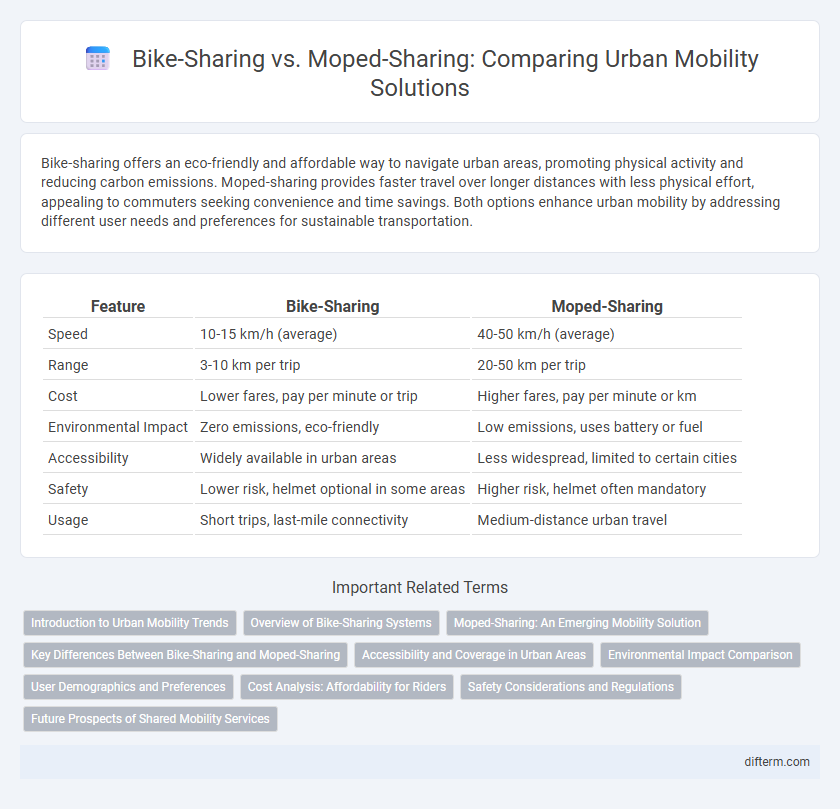Bike-sharing offers an eco-friendly and affordable way to navigate urban areas, promoting physical activity and reducing carbon emissions. Moped-sharing provides faster travel over longer distances with less physical effort, appealing to commuters seeking convenience and time savings. Both options enhance urban mobility by addressing different user needs and preferences for sustainable transportation.
Table of Comparison
| Feature | Bike-Sharing | Moped-Sharing |
|---|---|---|
| Speed | 10-15 km/h (average) | 40-50 km/h (average) |
| Range | 3-10 km per trip | 20-50 km per trip |
| Cost | Lower fares, pay per minute or trip | Higher fares, pay per minute or km |
| Environmental Impact | Zero emissions, eco-friendly | Low emissions, uses battery or fuel |
| Accessibility | Widely available in urban areas | Less widespread, limited to certain cities |
| Safety | Lower risk, helmet optional in some areas | Higher risk, helmet often mandatory |
| Usage | Short trips, last-mile connectivity | Medium-distance urban travel |
Introduction to Urban Mobility Trends
Bike-sharing and moped-sharing are transforming urban mobility by offering flexible, eco-friendly transportation options that reduce traffic congestion and carbon emissions. Recent data shows bike-sharing programs contribute to over 35% of short-distance trips in major cities, while moped-sharing appeals to users seeking faster travel over longer distances. Integration with public transit systems and app-based accessibility are key drivers boosting adoption rates and reshaping urban commuting patterns.
Overview of Bike-Sharing Systems
Bike-sharing systems provide a sustainable and affordable mobility solution by allowing users to rent bicycles for short trips through docked or dockless networks integrated with mobile apps. These systems promote urban accessibility, reduce traffic congestion, and lower carbon emissions, making them a vital component in smart city transportation planning. Compared to moped-sharing, bike-sharing offers quieter operation, lower maintenance costs, and encourages physical activity, appealing to environmentally conscious commuters.
Moped-Sharing: An Emerging Mobility Solution
Moped-sharing offers a flexible and efficient urban mobility solution by providing faster travel speeds and extended range compared to traditional bike-sharing systems. With electric mopeds reducing carbon emissions and alleviating traffic congestion, this emerging mobility option supports sustainable city transportation goals. Growing adoption in metropolitan areas highlights moped-sharing's potential to complement existing transit networks and enhance last-mile connectivity.
Key Differences Between Bike-Sharing and Moped-Sharing
Bike-sharing offers eco-friendly, low-speed transportation ideal for short, urban trips, with lower costs and easier accessibility for a wider demographic. Moped-sharing provides faster, more flexible mobility suited for longer commutes and hilly terrains, often requiring a valid driver's license and higher rental fees. Infrastructure support, safety regulations, and battery range are critical factors distinguishing the operational effectiveness of these two shared mobility options.
Accessibility and Coverage in Urban Areas
Bike-sharing systems offer extensive accessibility with docking stations commonly found throughout urban centers, facilitating easy pick-up and drop-off within dense neighborhoods. Moped-sharing provides broader coverage over longer distances and less accessible areas due to higher speeds and increased range, enhancing mobility beyond central hubs. Both services complement urban transport networks by addressing different transit needs, with bike-sharing favoring short, frequent trips and moped-sharing suitable for medium-range travel.
Environmental Impact Comparison
Bike-sharing systems produce minimal environmental impact due to zero emissions and reduced resource use, significantly lowering urban air pollution and carbon footprints. Moped-sharing, although more energy-efficient than conventional vehicles, still relies on batteries or fuel, resulting in higher emissions and resource consumption compared to bicycles. Cities prioritizing sustainability often favor bike-sharing programs to promote cleaner, greener urban mobility solutions.
User Demographics and Preferences
Bike-sharing attracts a diverse user base, including commuters, students, and recreational riders, particularly in urban areas with established cycling infrastructure. Moped-sharing appeals more to young professionals and short-distance travelers seeking faster and flexible transportation options in congested cities. User preferences often reflect the balance between affordability, speed, and ease of parking, with bike-sharing favored for eco-friendly trips and mopeds preferred for time-sensitive commutes.
Cost Analysis: Affordability for Riders
Bike-sharing services offer highly affordable rates, typically charging per 30-minute intervals at lower costs than mopeds, making them accessible for daily short-distance commutes. Moped-sharing, while slightly more expensive due to higher maintenance and fuel costs, provides greater speed and range, justifying the premium for longer urban trips. Cost-effectiveness for riders depends on trip duration and frequency, with bikes best suited for budget-conscious, brief rides and mopeds favored for quicker, mid-length travel.
Safety Considerations and Regulations
Bike-sharing systems generally face fewer stringent safety regulations compared to moped-sharing due to the slower speeds and lower risk of injury associated with bicycles. Moped-sharing services require users to comply with motor vehicle laws, including helmet use and minimum age restrictions, reflecting higher safety concerns and regulatory oversight. Ensuring proper maintenance and real-time monitoring of vehicle conditions is critical for both modalities to meet safety standards and reduce accident risks in urban mobility networks.
Future Prospects of Shared Mobility Services
Bike-sharing systems are projected to expand rapidly due to advances in electric bike technology and integration with urban transport networks, enhancing accessibility and reducing carbon emissions. Moped-sharing offers higher speed and longer range for urban commuters, with future prospects relying on improved battery life and regulatory frameworks to ensure safety and sustainability. The convergence of AI-driven fleet management and real-time data analytics will optimize operational efficiency and user experience across both shared mobility services.
bike-sharing vs moped-sharing Infographic

 difterm.com
difterm.com